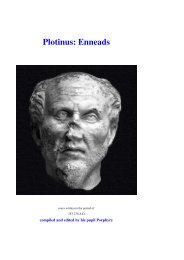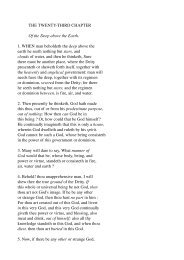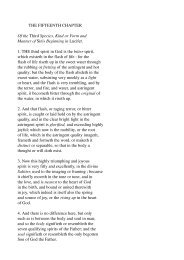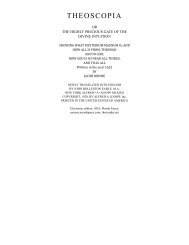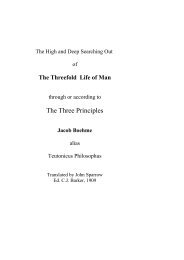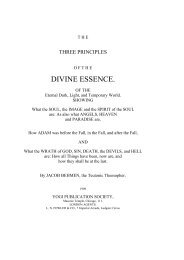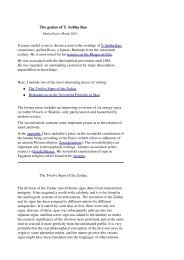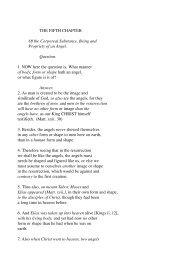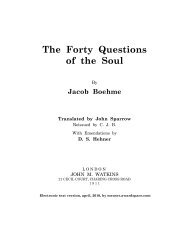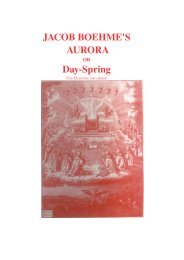Gerald Massey's Lectures - Society in evolution - Awardspace
Gerald Massey's Lectures - Society in evolution - Awardspace
Gerald Massey's Lectures - Society in evolution - Awardspace
You also want an ePaper? Increase the reach of your titles
YUMPU automatically turns print PDFs into web optimized ePapers that Google loves.
canonical gospels! Now it can be seen how the Messiah may be said to come rid<strong>in</strong>g on an<br />
ass, and upon a colt, the foal of an ass, although it is pitiful enough to give one the<br />
heartache, to expose the miserable pretences under which this mythical Messiah has been<br />
masked <strong>in</strong> human form, and made to put on the cast-off cloth<strong>in</strong>g of the pagan gods, and<br />
play their parts once more; this time to prove the real presence of a god <strong>in</strong> the world.<br />
It was as the mother-moon that Ishtar of Akkad was designated "Goddess Fifteen,"--she<br />
be<strong>in</strong>g named from the full moon <strong>in</strong> a month of thirty days. The same fact is signified <strong>in</strong><br />
the Egyptian Ritual (ch. 80), when the Woman of the moon at full orb exclaims,--"I have<br />
made the eye of Horus (the mirror of light), when it was not com<strong>in</strong>g on the festival of the<br />
15th day." She is the Egyptian form of the the swallower of the moon, is impersonated as<br />
a Jewish ruler who commands all the <strong>in</strong>nocent little ones to be murdered <strong>in</strong> order that he<br />
may <strong>in</strong>clude the child-Christ reborn for the overthrow of him who can only rule <strong>in</strong> the<br />
k<strong>in</strong>gdom of darkness. Now, if we bear <strong>in</strong> m<strong>in</strong>d that fox, jackal, wolf, and dragon are<br />
equally Typhonian types of the evil one, the destroyer, we may possibly <strong>in</strong>terpret a<br />
particular epithet applied to Herod, the destroyer, by the Christ <strong>in</strong> the gospel accord<strong>in</strong>g to<br />
Luke. When Jesus is told that Herod would fa<strong>in</strong> kill him, "he said unto them, Go and say<br />
to that fox, behold I cast out devils and perform cures to-day and to-morrow, and the third<br />
day I am perfected." The scene is obviously <strong>in</strong> the underworld, where the moon-god<br />
descended dur<strong>in</strong>g the three dark nights before he rose aga<strong>in</strong> or was perfected on the third<br />
day. It was here that the god as Khunsu, the caster-out of demons, or Horus, performed<br />
cures and exorcised the evil spirits that <strong>in</strong>fested the departed <strong>in</strong> their underground passage<br />
where the dragon Herod, or the Typhonian reptile Herrut, lurked, and sought to kill the<br />
healer of the diseased and deliverer of the dead.<br />
Hav<strong>in</strong>g identified Herod, the mythical monster, with the dragon, and as the fox, we may<br />
carry the parallel a little farther, and perhaps identify him as the traditional murderer of<br />
John!<br />
As already shown, <strong>in</strong> the Christian cont<strong>in</strong>uation of the legend, John takes the place of<br />
Taht-Aan, the dark one of the lunar tw<strong>in</strong>s. John and Jesus are equivalent to Aan and<br />
Horus. In the Apocryphal or Legendary Lore, John is often identified with and identified<br />
as the primary Messiah! He is so <strong>in</strong> the Apocryphal Gospel of James. In this, Herod is<br />
seek<strong>in</strong>g the life of the Div<strong>in</strong>e child, and he sends his servants to kill John. We read that<br />
"Herod sought after John, and sent his servant to Zachariah say<strong>in</strong>g, 'Where hast thou<br />
hidden thy son?' and Herod said 'his son is go<strong>in</strong>g to be the K<strong>in</strong>g of Israel." Here it is John<br />
who is to be the <strong>in</strong>fant Messiah whose life is sought by the destroyer Herod, and the fact,<br />
accord<strong>in</strong>g to the true mythos, is that John represents the first and that one of the lunar<br />
tw<strong>in</strong>s whom Herod, or the Typhonian devourer, does put an end to, because he personates<br />
the dark half of the lunation, the wan<strong>in</strong>g, lessen<strong>in</strong>g moon, that darkens down and dies. In<br />
the Zodiac of Denderah we see the figure of Anup pourtrayed with his head cut off; and I<br />
doubt not that the decapitated Aan or Anup is the prototype of the Gospel John who was<br />
beheaded by Herod. In the planisphere Anup stands headless just above the river of the<br />
Waterman, the Greek Eridanus, Egyptian Iarutana, the Hebrew Jordan; and we are told<br />
that the Mandaites, who were amongst the followers of John, had a tradition that the river<br />
Jordan ran red with the blood which flowed from the headless body of John.<br />
As I have previously po<strong>in</strong>ted out, the Christ of the Gospel accord<strong>in</strong>g to Luke has several<br />
features <strong>in</strong> common with the moon-god Khunsu, the healer of lunatics and persons<br />
possessed, who was likewise lord over the pig, a type of Typhon, the evil power. Khunsu<br />
followed Taht, as child of the sun and moon, after Taht had been, so to say, div<strong>in</strong>ized <strong>in</strong>to<br />
<strong>in</strong>visibility. Taht-Khunsu is the visible representative, who registers the decrees of the<br />
hidden Deity, Amen-Ra, the god who seeth <strong>in</strong> secret. He is particularly the god of health<br />
and long life. It is said that he gives years to those whom he chooses, solicits the superior<br />
powers for an extension of the lease of life, or "asks years" for whomsoever he likes, and<br />
<strong>in</strong>creases life <strong>in</strong> fulness and <strong>in</strong> length for those who do his will! "Life comes from him,



